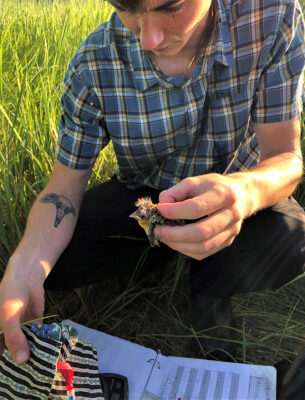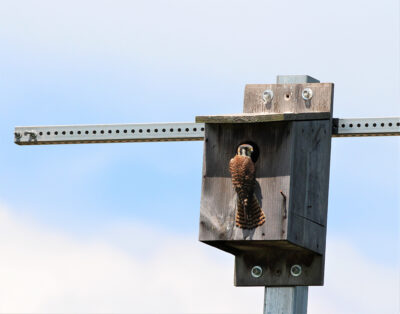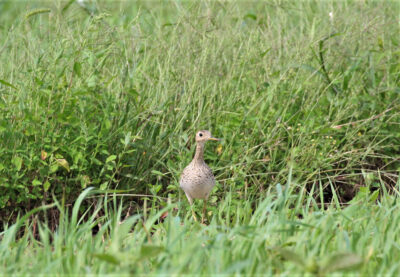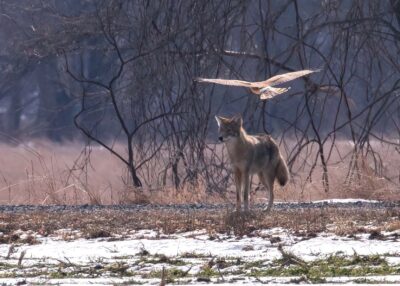
Leer en Español
By Anne Bloomfield, Applied Farmscape Ecology Manager
Photo of the Bobolink courtesy of Peter Schoenberger
Last June, I stood in the middle of an expansive field under a sunny, blue sky holding a tiny Bobolink chick in the palm of my hand. Like many grassland birds, their populations are currently in decline. Bobolinks, until recently, had likely not nested in the Hurley flats for decades. It was undeniable. The bird was there because of our deliberate efforts to create nesting habitat in this field. Optimism has felt hard to come by during the last two years. However, it is there nonetheless, showing up in moments when we least expect it. These moments bring delight and joyfulness, even celebration. But how can we be optimistic when there is a biodiversity crisis raging, the climate is shifting and the world appears gripped by a curiously permanent sense of instability? It is during these times I remind myself to sink into optimism, bask in it and unapologetically acknowledge that, in the midst of all of it, humans are still capable of having a reciprocal and even positive impact on the earth. We must first believe it is possible. Then, we must work consistently and attentively together to make it so.
As a nonprofit farm, we do not work under the same set of operational challenges as private, commercial farming operations. However, the task of stewarding the land at the Farm Hub with grassland birds in mind and producing crops is still real. In some areas of the farm, we are able to focus more on wildlife conservation efforts, while in other instances crop production timelines and activities need to take priority. Finally, there are the areas on the farm where we are able to prioritize both. A commitment to stewarding farmland with birds in mind is equally as important as finding practical ways in which one can honor that promise within a specific farm operation. This work comes with the understanding that, while we cannot prioritize both all of the time, we can work together to intentionally build on this effort routinely.

Behind each milestone, each egg, each chick is a healthy dose of humility, missteps, and humbleness. Then appears optimism in the form of wings and feathers, reassuring us to keep trying. As the years accumulate so do the fruits of our labor. Over the past six years, the farm has experienced a number of successes concerning our goals to steward the land with grassland birds in mind. Progress, such as nesting Bobolinks, Eastern Meadowlarks and American Kestrels, has come through active habitat management in specific areas of the farm. This has required problem-solving, conversation and targeted activities such as crop selection in specific fields, alternative mowing practices and installation of nesting boxes.
Other notable grassland bird successes have occurred as a result of our daily operations. Grassland birds prefer expansive, open, grassy habitats and often place their nests on the ground. The combination of our location in the landscape, a multi-year organic crop rotation of a diversity of field crops, vegetables and cover crops coupled with our general approach to soil health and biodiversity conservation has created habitat for a number of species. Some grassland birds use the habitat on the farm for raising their young in the spring and summer. Others refuel here during spring and fall migration. Lastly, some species of grassland birds forage and roost over the winter on the farm. We have observed Horned Lark chicks, Northern Harriers, Short-eared Owls, Sedge Wrens and Upland Sandpipers- all quite uncommon in this area.

This is not to say that the presence of grassland birds is necessarily symbolic of a “better way”. Rather, that if we set wildlife conservation goals with intention and sincerity we can have a positive impact, whatever those goals might be.
A journey
In 2015 our work began with creating an inventory of bird species on the farm. Then, we started conducting a long-term monitoring project, with the support of volunteers, looking at the on-farm habitats birds use year-round. In addition to who and where, we have recorded observations of migratory arrival and departure dates for migratory birds to both create historic records and better manage the farm for birds. These habitat use data, while useful in their own right, also help to inform research projects hosted on the farm as part of the Applied Farmscape Ecology Research Collaborative (AFERC). Our team continues to build our knowledge across disciplines in order to have a more holistic view of what it means to produce crops with birds in mind. We have observed 182 bird species, a number of which are species of conservation concern. Additionally, two fields on the farm, due to their shape, size and location have been designated “grassland bird areas”. In 2018, we documented our first Bobolink young in these fields and in 2020 confirmed nesting behavior of Eastern Meadowlarks. In 2021, near one of our grassland bird fields we documented Horned Lark young as well as the previously mentioned pair of Sedge Wrens. Over the years, these areas have included both hay mixes as well as a semi-perennial grain called kernza. Our observations at the Farm Hub resulted in the first documented cases of Bobolinks and Eastern Meadowlarks breeding in Kernza. To date, the Farm Hub has documented all 11 of New York State’s grassland bird Species of Greatest Conservation Need.

Several years ago, in partnership with a farmer trainee at the Farm Hub, the Applied Farmscape Ecology Program embarked on a project to install American Kestrel nesting boxes on hop poles in an organically managed hopyard. American Kestrels are small falcons that breed in grassland habitats such as meadows and pastures. Though this project ended, we still have two kestrel boxes which have successfully fledged young in two locations on the farm. In addition, several projects in the Applied Farmscape Ecology Research Collaborative focus on birds. This includes a project examining Bobolink movements year-round. While not grassland bird-focused specifically, two other projects investigate overwintered cover crops as bird habitat and the services birds might provide to crops in the Northeast.
At present, the Applied Farmscape Ecology Program at the Farm Hub continues to work closely with other program areas, crop production staff, the buildings and grounds team and construction team to continue to build grassland bird conservation into our work. Finally, through the work of the research collaborative as well as public walks on the farm and citizen science efforts, we continue to grow our public engagement work to help protect birds, provide opportunities for the public to observe birds, and support growers who want to manage their farms with birds in mind.

While we still have much work to do, it feels important to share this update with you, our neighbors, and our community. In these words, I hope not to necessarily inspire you to do just as we have done, but to consider what is possible when we work with, rather than against, one another. There is a saying that diversity is resilience. Whether biodiversity, cultural diversity, or a diversity of perspectives – this mantra has rung true in many parts of my life, including wildlife conservation and land stewardship. A mentor once told me, “wildlife management is people management”. When we consider wildlife conservation from only the perspective of the biologist or only the perspective of the farmer, some progress is still possible, but much is lost. But together, especially when we are willing to confront challenges through open dialogue and lean into the uneasiness of our differences, we find strength. We find optimism. A colleague at the farm likes to say, “what you sow is what you reap”. This is environmental justice. This is where resilience lies. Not within any one of us, but in us all.
RESOURCES
To learn more about grassland birds please see the following resources.
Wonder of the Bobolink Film
Noah Perlut’s Research Page
John Burroughs Natural History Society
National Audubon Christmas Bird Count
New York State Grassland Bird Species of Greatest Conservation Need
Stewards of the Land Article
Kestrel Article
Maine Somerset County Soil and Water Conservation District “Ag Allies Grassland Birds Project”
Maine Somerset County Soil and Water Conservation District “Grassland Habitat Conservation”
